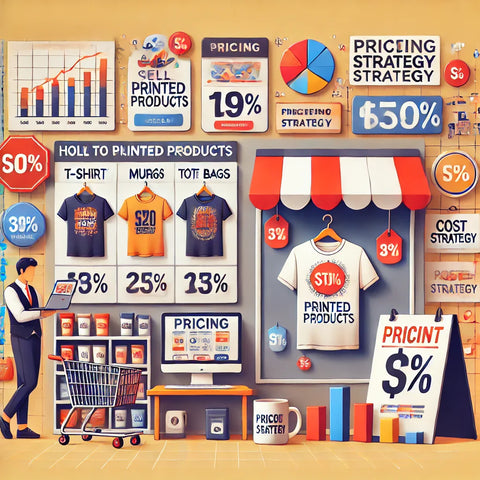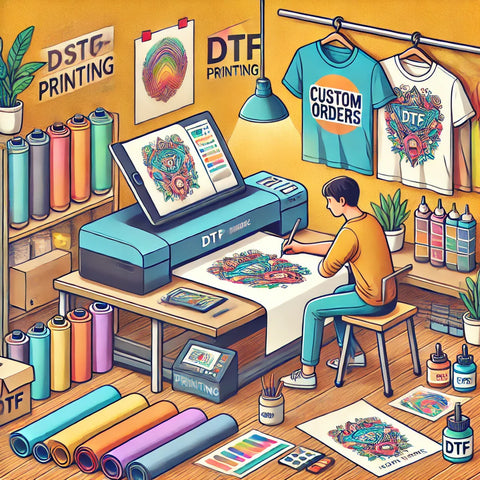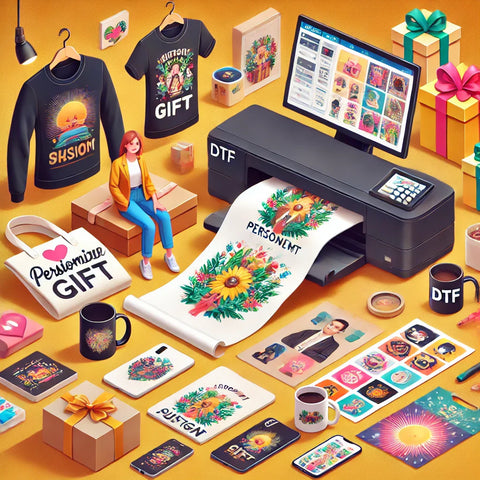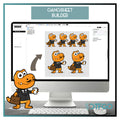Selling printed products in a competitive market requires more than just great designs—it also demands smart pricing strategies. Whether you’re selling custom t-shirts, hoodies, tote bags, or DTF transfers, pricing your products competitively can help you stand out, increase conversions, and build a loyal customer base.
But how do you set the right price that attracts customers while ensuring healthy profit margins? In this guide, we’ll explore proven pricing strategies to help you sell printed products at competitive rates without sacrificing quality or profitability.
1. Understand Your Costs Before Setting Prices
Before you determine your selling price, you need to understand all your costs to avoid underpricing your products.
Key Cost Factors to Consider:
💰 Material Costs – T-shirts, hoodies, tote bags, or other blank products.
🖨 Printing Costs – DTF transfers, screen printing, sublimation, or DTG costs.
📦 Packaging & Shipping – Boxes, envelopes, labels, and shipping rates.
⚡ Overhead Costs – Rent, utilities, website fees, and marketing expenses.
📉 Platform Fees – Etsy, Shopify, Amazon, or other marketplace commissions.
📌 Formula to Calculate Your Base Cost:
Total Cost Per Product = (Material + Printing + Shipping + Overhead) ÷ Number of Units
Pro Tip: Keep a detailed cost breakdown in a spreadsheet to track expenses and ensure your pricing remains profitable.
2. Research the Market & Analyze Competitor Pricing
To set competitive prices, research what other sellers in your niche are charging.
How to Analyze Competitor Pricing:
✔ Check Etsy, Amazon, and Shopify Stores – Look for stores with high sales volume.
✔ Compare Similar Product Listings – Find businesses selling similar designs and materials.
✔ Consider Pricing Ranges – Identify the lowest, average, and highest price points.
✔ Read Customer Reviews – Customers may mention if a product is "too expensive" or "a great value."
Example Pricing Breakdown for a DTF-Printed T-Shirt:
- Low-end competitor price: $15
- Mid-range price (most sellers): $22 - $28
- High-end price (premium brands): $35+
🚀 If your production cost is $10 per unit, selling at $25 gives you a $15 profit per sale.
3. Choose the Right Pricing Strategy
Different pricing models can help you attract customers while ensuring profitability.
Common Pricing Strategies for Printed Products:
1️⃣ Cost-Plus Pricing – Add a fixed markup percentage to your cost price.
✔ Formula: Cost Price + Markup = Selling Price
✔ Example: If a hoodie costs $15 to produce, adding a 100% markup makes the selling price $30.
2️⃣ Market-Based Pricing – Set your price based on what competitors are charging.
✔ Example: If most custom t-shirts sell for $22-$28, position your price within that range.
3️⃣ Value-Based Pricing – Charge based on the perceived value of your brand and product.
✔ Example: Premium, high-quality DTF transfers can sell for higher prices than generic ones.
4️⃣ Bundle Pricing – Offer multiple products together at a discounted price.
✔ Example: A "3 for $50" t-shirt bundle can encourage larger purchases.
5️⃣ Loss Leader Pricing – Sell a popular product at a lower profit to attract customers.
✔ Example: Offer discounted t-shirts but charge higher margins on accessories.
Pro Tip: Test different pricing strategies and see which works best for your audience.
4. Offer Discounts & Promotions to Increase Sales
Strategic discounts and promotions can help you stay competitive and boost revenue.
Best Discount Strategies for Print Sellers:
🎯 First-Order Discounts – Give new customers a 10-20% discount to encourage first-time purchases.
📦 Bulk Order Discounts – Offer discounts for higher quantity orders (e.g., “Buy 3, Get 1 Free”).
🔥 Limited-Time Sales – Create urgency with holiday sales, flash deals, and seasonal promotions.
💰 Loyalty Discounts – Offer returning customers exclusive discount codes.
📌 Example:
“Get 20% off your first DTF transfer order – Limited Time Only!”
Pro Tip: Promote discounts via email marketing and social media ads to increase reach.
5. Reduce Production Costs Without Compromising Quality
Lowering costs allows you to offer better prices while maintaining healthy profit margins.
Cost-Saving Tips for Printing Businesses:
✅ Buy in Bulk – Order blank apparel or transfer sheets in bulk for discounts.
✅ Use Local Suppliers – Reduce shipping costs by sourcing materials locally.
✅ Streamline Printing Processes – Choose efficient printing methods like DTF for lower costs.
✅ Reduce Returns & Waste – Offer accurate sizing charts and quality control to avoid reprints.
🚀 By reducing production costs by just $2 per unit, you can either lower prices OR increase profits!
6. Offer Free Shipping Smartly
📦 Did you know? 70% of online shoppers prefer stores that offer free shipping.
How to Offer Free Shipping Without Losing Profit:
✔ Increase Product Prices Slightly – Cover shipping costs in the product price.
✔ Set a Minimum Purchase for Free Shipping – (e.g., "Free shipping on orders over $50").
✔ Use Discounted Shipping Services – Negotiate rates with carriers like USPS, FedEx, or DHL.
📌 Example:
Instead of charging $20 + $5 shipping, set the price at $25 with free shipping.
Pro Tip: Run A/B tests on your store to see if "free shipping" increases conversions.
7. Position Your Brand as “High-Value” Instead of “Cheap”
While pricing competitively is important, customers don’t always buy the cheapest option—they buy from brands they trust and perceive as valuable.
How to Make Your Brand Stand Out:
🌟 Use High-Quality Product Mockups – Show designs in professional, realistic settings.
📝 Write Compelling Product Descriptions – Highlight unique selling points (e.g., "Super soft, long-lasting print").
📸 Showcase Customer Reviews – Social proof builds trust and justifies pricing.
🎥 Create Video Content – Show the printing process and behind-the-scenes details.
✅ Example: If selling a $30 premium hoodie, emphasize:
✔ "Ultra-soft, premium cotton blend"
✔ "Durable DTF print – lasts 50+ washes"
✔ "Eco-friendly, made with sustainable inks"
Pro Tip: Customers will pay more for perceived value—so focus on branding, quality, and customer experience!
Final Thoughts: Pricing Smart for More Sales & Profit
Successfully selling printed products at competitive prices requires a balance between affordability, value, and profit margins.
📌 Key Takeaways:
✔ Know your production costs to avoid underpricing.
✔ Analyze competitor pricing to position your brand effectively.
✔ Use smart pricing strategies like bundles, discounts, and free shipping.
✔ Lower production costs while maintaining high product quality.
✔ Focus on branding and perceived value to justify higher prices.
🚀 Ready to price your products strategically? Apply these tips and watch your sales and profits grow!






